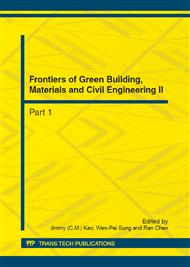[1]
Wan Rong, Liu Jiaping, Kong Dequan: Energy Efficient, Green and Sustainable Development Buildings. Sichuan Building Science, Vol. 32 (2007), pp.150-152.
Google Scholar
[2]
Ministry of Construction. China Construction News• Chinese Property Market. 2005. 8. 2.
Google Scholar
[3]
Sun Zhijuan. Green Buildings Facing the Economic and Social Problems. Sichuan Building Science, Vol. 33 (2007), pp.171-179.
Google Scholar
[4]
Tu Fengxiang, Wang Qingyi. Status and Development of China's Building Energy Conservation. New Building Materials, Vol. 7(2004), pp.40-42.
Google Scholar
[5]
Group of China's Energy Development Strategy and Policy Research. Research on China's Energy Development Strategy and Policy. Beijing: The Publishing House Of Economic Science, (2004).
Google Scholar
[6]
Jiang Yi. Current Building Energy Consumption in China and Effective Energy Efficiency Measures. Hv& Ac, Vol. 35(5) (2005), pp.30-40.
Google Scholar
[7]
Tu Fengxiang. Building Energy Conservation (41). Beijing: China Architecture & Building Press, (2003).
Google Scholar
[8]
Long Weiding. Proportion of Energy Consumption of Building Sector and Target of Building Energy Efficiency in China. Energy of China, Vol. 27 (2005), pp.23-27.
Google Scholar
[9]
Xia Chunmei. Characters of Green Building and Discussion on Its Design Method[J]. Journal of Shenzhen University(Science &Engineering), Vol. 16 (1999), pp.73-77.
Google Scholar
[10]
Zhou Hui. Research on Air Conditioning Index of Office Building Energy Consumption. Tongji University, (2003).
Google Scholar
[11]
Zhou Yang, Wu Wenxiang, Hu Ying. Assess of Availability of Solar Energy Resources in Jiangsu Province. Renewable Energy Sources, Vol. 28(2010), pp.10-13.
Google Scholar
[12]
Su DengChao, Zhang Qiang, Du QingYi. Unsteady-state Numerical Simulation of Load and Ventilation Efficiency for the Room with Displacement Ventilation. Journal of Xian University of Architecture & Technology(Natural Science Edition), Vol. 39(2007).
Google Scholar


